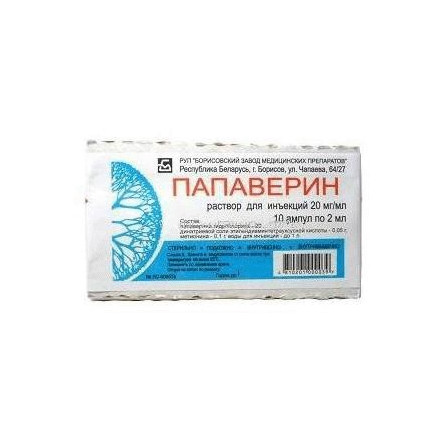Papaverine hydrochloride injection solution ampoules 2% 2ml N10
Condition: New product
969 Items
Rating:
Be the first to write a review!

More info
Active ingredients
Papaverine
Release form
Solution
Composition
active ingredient - Papaverine hydrochloride - 0.04 g in 2 ml of solution, excipients: methionine, ethylenediaminetetraacetic acid disodium salt, water for injection.
Pharmacological effect
Myotropic antispasmodic. Inhibits PDE, causes accumulation of cAMP in the cell and reduces the content of intracellular calcium. Reduces the tone of smooth muscles of internal organs (gastrointestinal tract, respiratory, urinary, reproductive system) and blood vessels. Causes dilation of arteries, contributes to increased blood flow, incl. cerebral It has a hypotensive effect. In high doses, it reduces the excitability of the heart muscle and slows down intracardiac conduction. When used in moderate therapeutic doses, the effect on the CNS is weak.
Pharmacokinetics
After subcutaneous and intramuscular administration is rapidly and completely absorbed. Therapeutically effective plasma concentrations of the drug are 0.2-2.0 μg / ml. With repeated use of the drug its pharmacokinetics do not change. Binds to plasma proteins by 90%. Easily passes through histohematogenous barriers. In the liver and adipose tissue forms a depot. Subjected to biotransformation in the liver. The half-life of T1 / 2 papaverine is 0.5-2.0 hours. Excreted in the form of metabolites in the urine, small amounts (less than 0.5%) in unchanged form.
Indications
Indications for the use of the drug Papaverina hydrochloride are: spasm of smooth muscles of the abdominal organs (cholecystitis, pylorospasm, spastic colitis, renal colic); peripheral vasospasm (endarteritis); spasm of cerebral vessels; angina (as part of complex therapy); bronchospasm.
Contraindications
- children's age up to 1 year; - respiratory depression or coma; - AV block; - hypersensitivity to papaverine; - glaucoma; - age over 75 years (risk of hyperthermia); - Peyronie's disease (for intracavernous administration).
Precautionary measures
Extreme caution. Care should be taken to use only small doses of papaverine in patients with traumatic brain injury, impaired liver and kidney function, hypothyroidism, and adrenal insufficiency, as they increase the hypotensive effect of papaverine.In individuals with benign prostatic hyperplasia, high doses of papaverine can trigger acute urinary retention.
Use during pregnancy and lactation
During pregnancy and lactation, the safety and efficacy of papaverine hydrochloride have not been established.
Dosage and administration
Enter subcutaneously, intramuscularly or intravenously. Adults are prescribed 20-40 mg (1-2 ml of a 2% solution) 2-4 times a day (the interval between injections is at least 4 hours). When administered intravenously, 10 mg (1 ml of 2% solution) is dissolved in 10-20 ml of 0.9% sodium chloride solution. The highest single dose of 200 mg (10 ml of 2% solution), daily dose of 300 mg (15 ml of 2% solution). When treating erectile dysfunction of vascular genesis, intracavernous (in the cavernous bodies of the penis) 10 mg (0.5 ml of 2% solution) for 20-30 minutes before the planned sexual activity. In persons over 70 years old, the initial single dose of papaverine is not more than 10 mg (0.5 ml of 2 solution). Children aged 1 to 12 years old are prescribed in a dose of 0.3- 0.5 mg / kg body weight 2-3 times a day.
Side effects
- nausea, constipation. - drowsiness, increased sweating. - increased transaminase level, eosinophilia. - hypotension, AV-blockade, ventricular extrasystole. - fibrous induration of the penis, priapism with intracavernous administration.
Overdose
Symptoms of intoxication appear with the introduction of high doses, especially against the background of the pathology of the liver and kidneys. The appearance of diplopia, weakness, drowsiness, hypotension is characteristic. There is no specific antidote. Aid measures include the abolition of the drug, gastric lavage with milk and activated carbon, supportive and symptomatic therapy aimed at eliminating the resulting disorders and increasing blood pressure. In severe cases, resorted to hemoaspiration and bypass surgery on the vessels of the penis.
Interaction with other drugs
With simultaneous use of papaverine, potentiates the effect of alcohol, weakens the hypotensive effect of methyldopa. In smokers, the metabolism of papaverine is accelerated, and its plasma concentration and pharmacological effects decrease. (analgin) and diclofenac potentiate the antispasmodic effect of papaverine. Solutions of papaverine are pharmaceutically incompatible with glucose solutions (partial inactivation of pas paverina).
special instructions
Papaverine hydrochloride in liquid dosage forms is incompatible with alkalis and substances with an alkaline reaction (precipitation of papaverine base occurs), halogens (due to precipitation of papaverine halides), sodium chloride and calcium chloride (precipitation), sodium benzoate and sodium salicylate ( the sparingly soluble papaverine benzoate and papaverine salicylate are formed). Use in pediatrics. The use of papaverine hydrochloride in children of the 1st year of life is not recommended due to the high risk of hyperthermia. Influence on the ability to drive vehicles and control mechanisms. At therapeutic doses, papaverine does not adversely affect the ability to drive a motor vehicle or other operator activity.


